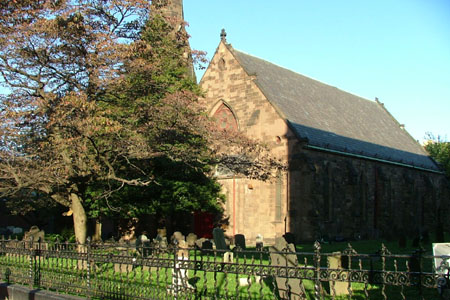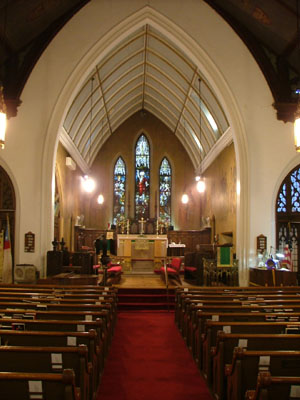| |
 |
 |
 |
| Comment on this report, or find other reports. |
 |
| Our Mystery Worshippers are volunteers who warm church pews for us around the world. If you'd like to become a Mystery Worshipper, start here. |
 |
| Find out how to reproduce this report in your church magazine or website. |
|
|
| 2077: Grace Episcopal,
Jamaica, New York, USA |
 |
 |
 |
Mystery Worshipper:
Amanda B. Reckondwythe.
The church:
Grace Episcopal, Jamaica, New York, USA.
Denomination:
The Episcopal Church, Diocese
of Long Island.
The building:
The present church was begun in 1861, replacing two earlier
structures, and consecrated in 1863. The chancel was not added
until 1902. It is a rough-cut brownstone Gothic Revival church
with a tall spire. In the graveyard rest the earthly remains
of several elected officials and gentry from colonial times,
including Rufus King, one of the signers of the United States
Constitution and an unsuccessful presidential candidate in the
election of 1816. The interior is typical church, with three
steps up from the nave to the quire and three more up to the
chancel. Stations of the cross line the walls. Stained glass
windows depict scenes from the life of Christ, with one window
dedicated to St Cecilia, who holds a portative organ and is
attended by angels with sharpened quill pens. Three windows
behind the altar depict the resurrection. A mural on the rear
wall shows Christ in glory attended by angels and 11 of the
apostles (with Judas noticeably absent). Murals in the quire
depict saints who championed freedom for slaves, surrounded
by their charges.
The church: The congregation was founded in 1702 and the church was the official church of the British colonial government until the Revolutionary War. Today they sponsor all the usual organizations, including Scouts, Episcopal Church Women, Brotherhood of St Andrew, an emergency food pantry, and fellowship groups for all ages. There are two services each Sunday and one each weekday.
The neighborhood:
Jamaica, in New York Cityís borough of Queens, was settled in
1656 by the Dutch, who named it Rustdorp (literally "retirement
village"). When the British took over, they changed the
name to Yamecah, which is what they called the Native Americans
living there (later corrupted to coincide with the name of the
Caribbean island). Long a bastion for African-Americans, the
neighborhood today is ethnically diverse. The church and graveyard
form an oasis of green on Jamaica Avenue, a rather seedy commercial
main street that was a trade route even in Dutch colonial times.
Nearby is the Long Island Rail Roadís Jamaica station, a major
junction of rail and subway lines and the Airtrain to JFK Airport.
The neighborhood bustles with cheap eateries and bargain shops.
The cast: The Revd Darryl F. James, priest in charge, was the celebrant. Assisting were the Revd Deacon Charles L. Perrin, who also preached; Charles Kelly, Sr, verger; Cristopher Stone, organist; Leon Dacon and Ellen Duran, lectors; and Judith Edwards, intercessor.
The date & time: Twenty-First Sunday after Pentecost, October 17, 2010, 10.00am. The notice board outside the church announced a 9.15 service; I arrived at 8.45 to discover a mass already well underway. A lady handed me a service booklet that announced masses at 9.00 and 10.00 on the cover, but at 8.00 and 10.00 on an inside page. I told the lady Iíd be back at 10.00.
What was the name of the service?
Eucharist.
How full was the building?
I counted room for about 300; it was two-thirds full. Mostly elderly women, some middle aged men and women and a few young adults, hardly any children. Predominantly blacks of Caribbean ethnicity, judging from their accents.
Did anyone welcome you personally?
The lady who had previously given me the service booklet said,
"Oh, youíre back!" Another lady said good morning
as she passed me in my pew.
Was your pew comfortable?
Basically so Ė wooden pew with red upholstered cushions. The kneelers, though, were the hassock type that I always find uncomfortable.
How would you describe the pre-service
atmosphere?
Lots of rather noisy visiting, but after that was done people
settled in quietly. An apparently homeless man wandered the
aisles muttering to himself and asking people for money. Most
ignored him, but finally an old lady told him "Youíre a
nice person; go andÖ" (I didnít catch the rest). I thought
she may have said, "Go and show yourself to the priests,"
as he muttered his way into the sacristy and emerged shortly
thereafter, unfortunately not looking particularly healed.
What were the exact opening words of the
service?
"Good morning. Our processional hymn is number 535: 'Ye Servants
of God'." The procession was led by a crucifer in alb and gold
scapular, the choir in cottas and purple cassocks, the acolytes
in albs and white scapulars, the verger in a blue robe and white
vergerís gown, the deacon in alb, white dalmatic and green deaconís
stole, and the celebrant in green chasuble.
What books did the congregation use during the
service?
Hymnal 1982, Lift Every Voice and Sing II, and a service
leaflet. The leaflet contained all the prayers and readings,
so we didnít need the Prayer Book 1979 although it
was in the pews.
What musical instruments were played?
An electronic organ and grand piano. There was also a mixed choir of about 12 voices.
Did anything distract you?
Most of the stations of the cross on the walls were crooked; I resisted the urge to get up and straighten them. The deaconís sermon was accompanied by a chorus of ringing cell phones and by a child who ran back and forth across the rear of the church, thump-thump-thumping his feet and making screeching sounds (his mother finally took him outside). At communion, one of the ushers was visibly chewing gum.

Was the worship stiff-upper-lip, happy clappy, or
what?
A nicely done by-the-book Rite II eucharist. The celebrant chanted
his parts in a delightful tenor voice. The psalm was done to
Anglican chant and included a doxology. The verger really earned
his keep Ė he verged both the readers and the intercessor to
the lectern, greeting each with a bow. There were bells (and
more Ė see the hellish bits) but no incense. The hymns were
all traditional and the people sang with gusto. At the peace,
there was a general exchange of handshakes, and then everyone
lined up in the aisles receiving-line fashion, joined hands,
and sang "Thereís a sweet, sweet spirit in this place"
while the altar party worked the line, shaking hands and kissing.
Exactly how long was the sermon?
27 minutes.
On a scale of 1-10, how good was the preacher?
9 – I liked the sermon very much but refrain from giving it a 10 because of its length. The deacon spoke from the quire steps and did not use notes. He spoke with a friendly, intimate tone and made good eye contact.
In a nutshell, what was the sermon
about?
The Old Testament is sometimes called "the Law." Contrast
this to the New Testament, which chronicles how Jesus impacted
our relationship with God. The Church teaches that the Old and
New Testaments contain all that is necessary for salvation,
and yet there is much disagreement over what is scripture and
what is not. The Episcopal Church gives credence to the books
that comprise the Apocrypha, while most other Protestant churches
ignore them and the Roman Catholic Church includes them among
the canonical books. There is also disagreement over whether
scripture is the literal word of God, dictated to scribes, or
rather an interpretation of how people saw the hand of God in
their lives. Even those who see it as the literal word of God
sometimes pick and choose which passages they will follow and
which they will ignore. The Bible can mean different things
to different people at different times, but this doesnít mean
that "anything goes". When we turn away from God through
sin, we punish ourselves Ė God doesnít punish. But God is ready
to forgive us if we turn back to him.
Which part of the service was like being in
heaven?
It was heavenly to watch the verger do his work. And I loved the way everyone sang with such energy. This is clearly a congregation who enjoy worshipping.
And which part was like being in... er... the other place?
After the peace came an interminable string of announcements Ė at least a half-hourís worth: a description of the acolytesí outing to the Washington National Cathedral, news about upcoming Bible study classes, a piece about an upcoming film on how blacks are depicted in the cinema, etc. Visitors were asked to stand (Miss Amanda didnít, and there were apparently no others), as were people having birthdays or celebrating anniversaries. All well and good, but peopleís bladders are sometimes unforgiving of things that drag on so. Finally Ė the bells at the elevation were augmented by the organist playing bell-like sounds using the organís celesta stop. Not liturgical and totally unnecessary!
What happened when you hung around after the service looking lost?
I was pretty much ignored. The lady sitting in front of me said,
"Have a good week." Another lady asked if I was going
to the parish house for coffee. As I was leaving, the priest
asked if I had been there before and what my name was. He hoped
that I would come back to visit when I am in town again.
How would you describe the after-service
coffee?
I found my way to the parish house and into a large room with
tables and chairs. Coffee urns were set out on a table but no
coffee appeared to be brewing. A scattering of old ladies took
up positions at the tables; most of the congregation appeared
either to be skipping coffee or had not yet arrived. "Can
I help you?" a lady in an apron asked, apparently thinking
that I didnít belong there. Indeed, I felt very much like I
didnít belong, so I left.
How would you feel about making this church your regular (where 10 = ecstatic, 0 = terminal)?
7 – This is a hard one. I liked the dignity of the mass and the spirit of the congregation, but I was put off by the odd circumstances of the coffee hour Ė no coffee, not many people, and definitely no welcome.
Did the service make you feel glad to be a
Christian?
Yes.
What one thing will you remember about all this in seven days' time?
Noticing how quickly my mood had evaporated as I left the "coffee
hour". |
|
|
 |
 |
 |
| We rely on voluntary donations to stay online. If you're a regular visitor to Ship of Fools, please consider supporting us. |
 |
 |
 |
| The Mystery Pilgrim |
 |
| One of our most seasoned reporters makes the Camino pilgrimage to Santiago de Compostela in Spain. Read here. |
 |
 |
 |
| London churches |
 |
| Read reports from 70 London churches, visited by a small army of Mystery Worshippers on one single Sunday. Read here. |
| |
|
|
|
|


